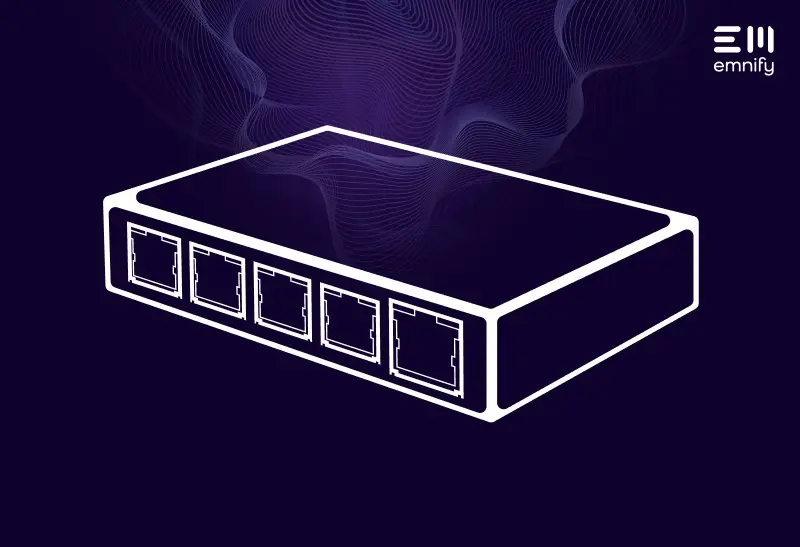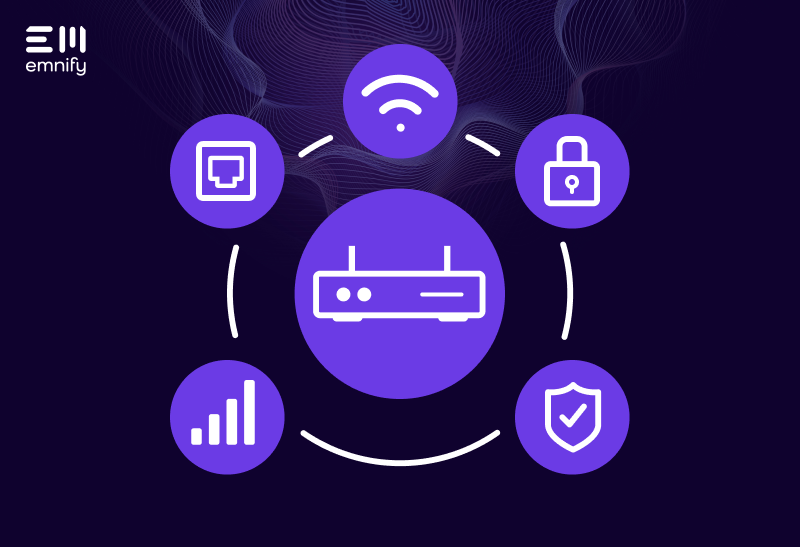

Quick definition: An edge router is a component of network infrastructure that operates at the “edge” of a network to connect it to the public Internet or a Wide Area Network (WAN) such as a cellular network. It enables remote access from outside the network, secures data transmissions to and from the network, and helps prioritize communications to improve service.
Table of Contents
- What are the benefits of an edge router?
- Real-world use cases
- Find the right router for your business
Edge routers represent the border crossing between internal and external networks, protecting your internal network devices, applications, infrastructure, and data from unauthorized external communications.
The term “edge router” is less about a specific type of router and more about its function.
However, the fact that edge routers perform specific jobs informs the types of routers which are best suited to serve as edge routers. For example, you can technically use software to create a “virtual edge router,” but the underlying hardware would likely limit its quality.
And when you’re managing a network for a business, you want purpose-built components to keep operations running smoothly—especially if your network includes Internet of Things (IoT) devices.
IoT deployments often include specialized routers, which can be edge routers or core routers depending on their role in the network.
This article will clarify what sets an edge router apart and its benefits to networks in general, and IoT businesses in particular.
What’s the difference between an edge router and a core router?
On a basic level, a core router is at the center of a network and facilitates internal communications between network entities, while an edge router is at the outer border of the network, facilitating communications between internal and external network entities that are typically separate and distinguishable.

All communication goes through the core router, but when the communication is going between networks, the edge router serves as a buffer.
A core router will often prioritize speed and minimize congestion and packet loss because it has to handle a significant volume of data and keep transmissions moving smoothly. It also has fewer threats to manage.
But an edge router prioritizes security, and may deal with a significantly lower volume of transmissions but more unique threats and complex interactions.
Imagine you’re going to a bar. Before you enter, you have to show your ID to a bouncer, who verifies its authenticity and may inspect you before letting you join the rest of the patrons. This same person may also help ensure those inside the bar comply with local regulations. For example, in some cities, patrons cannot take drinks outside, and the bouncer would help prevent this.
This is an edge router’s job in a network—it protects the internal network entities by governing interactions with external network entities.
Edge routers may at times slow down interactions because they have to implement security protocols and queues to ensure these communications are authorized. They may even prioritize certain types of transmissions or communications from certain entities, like a VIP line.
The core router is more like the head bartender or manager—it facilitates, enables, and optimizes all of the interactions between patrons, staff, and the bar itself. In a network, the core router streamlines internal communications between networked computers, smartphones, servers, and IoT devices.
In IoT deployments, the role of edge routers can be multifaceted. While it’s not uncommon for a single router to serve both core and edge functions in smaller networks, larger and more complex deployments often require dedicated edge routers for specific tasks. A notable example is in industrial IoT applications, where edge routers are crucial for aggregating and transmitting bulk data.
This is particularly important when IoT devices generate substantial data that needs to be sent securely and efficiently to a central system or cloud infrastructure. The choice of router, and its configuration, heavily depends on the type of IoT deployment and the connectivity requirements of the devices involved.
Some IoT devices integrate directly into the end user’s local network via Wi-Fi or Ethernet. In contrast, others, particularly in industrial settings, require the robust and high-capacity data handling capabilities of an edge router to communicate with external networks such as cellular solutions.
What are the benefits of an edge router?
Edge routers provide several general benefits to networks where internal and external devices, applications, and infrastructure need to communicate. In IoT, these benefits can be critical to an application’s success or failure, especially since IoT devices are often too small and limited to provide these functions for themselves.
It keeps your internal network secure
Not all network entities have the data throughput or power supply they need to handle complex security processes like encryption and authentication. Especially IoT devices, which often rely on small, single-use batteries.
These devices may need to communicate regularly with external network entities (or they may be external network entities to the end user), but they can’t use security protocols like IPsec or TLS. An edge router has a hardwired power supply and far more processing capabilities, so it can encrypt outbound transmissions, authenticate senders and recipients, and verify whether data packets have been altered.
But this isn’t only valuable because some devices can’t secure their own communications—internal networks are often optimized for other goals, like speed, volume, and accuracy. These resources don’t need to devote as much processing power to security for the majority of their operations. Having a dedicated router for securing external data transmissions keeps the rest of the network resources optimized for their primary use.
It can help facilitate remote access
Edge routers can give remote employees access to a company’s internal network through a Virtual Private Network (VPN). But in IoT, remote access is also critical for vendors to troubleshoot their devices.
When you have thousands of devices deployed across multiple sites, you don’t want to send a technician to perform diagnostics every time there’s a connectivity issue. Edge routers let your employees connect to VPNs on demand to access devices and perform firmware updates as needed.
It can use better Quality of Service (QoS)
As data packets pass between network entities, congestion can cause latency, packet loss, jitter, and other problems that affect service. Quality of Service (QoS) is technology that coordinates transmissions to improve network performance. Edge routers can utilize advanced QoS technology to prioritize communications for specific devices and create queues, helping businesses keep service smooth at scale.
Real-world use cases
- Smart buildings: In smart building applications, edge routers play a crucial role in managing and securing the data flow from numerous IoT devices like climate controls, security systems, and energy meters, ensuring efficient building automation and enhanced occupant comfort.
- Fleet management: For fleet management systems, edge routers are essential for aggregating and transmitting real-time data from vehicles, such as location tracking, fuel usage, and maintenance needs, facilitating optimized routing, improved safety, and efficient fleet operations.
- PoS systems: For PoS systems, edge routers provide secure and reliable connectivity, ensuring smooth transaction processing, data encryption, and seamless integration with broader retail management networks, thus enhancing customer experience and operational efficiency.
Find the right router for your business
emnify doesn’t sell routers. However, our expertise extends to ensuring your IoT deployments are maximized though seamless integrations with advanced connectivity solutions like the emnify IoT SuperNetwork.
The SuperNetwork is a cornerstone for IoT networks that rely on edge routers, offering reliable, redundant coverage vital for such deployments. As a cloud-native platform, it not only provides comprehensive insights into network performance, but also enables efficient management of large-scale Iot deployments.
Whether your IoT setup integrates directly with local networks or depends on the sophisticated data handling of edge routers, the SuperNetwork is designed to ensure a secure, scalable and seamless IoT experience, aligning with the evolving needs of modern, cloud-native businesses.
To help you make the right choice for your business, check out our guide, How to Choose the Best IoT Router.
Get in touch with our IoT experts
Discover how emnify can help you grow your business and talk to one of our IoT consultants today!

Bronwyn Hemus
With a career spanning over 18 years in storytelling and content creation, Bronwyn translates technical concepts and ideas into snackable and easy-to-digest content.



